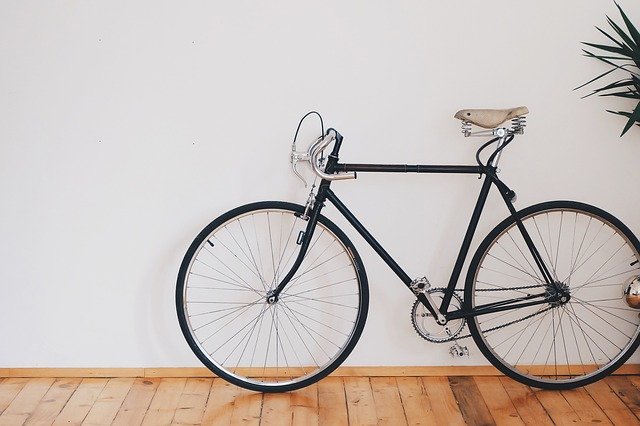Any bicycle needs a chain, which is an essential part. You can go forward by pedaling, which delivers power to the wheels. You can’t move the bike ahead while it’s loose because the rate of power transfer decreases.
You may occasionally have a loose or detached chain if you ride your bike frequently. It doesn’t necessarily imply that the bike is in need of repair. You can easily learn how to tighten a bike chain with the appropriate equipment.
Table of Contents
Required Tools:
The following tools should be close at hand before you start tightening your bike chain.
- Wrench & Adaptor for Sockets (if you have it, not necessary)
- Allen key or tool
- Use a bike stand or a flat surface to flip your bike over.
- Bike chain lubricant
- Cloth or a Rag
If you don’t want to get your hands dirty, wear hand gloves.
How To Cinch A Single-Speed Bike’S Chain
Place The Bicycle Inverted
Flip your bike upside down and position it on a bike stand or a flat surface with the saddle (seat) on the ground and wheels in the air to have simple access to the bike parts (rear axle, chain, rear tire).
To avoid any damage, cushion the saddle with a mat or many old newspapers (if you still have those).
Pro tip: Take pictures of the bike parts before disassembling them using your phone before removing any bicycle components. This will make it easier for you to recall where each part goes in the future.
Your Rear Tire’S Bolts
To adjust your bike chain, you’ll need to loosen the back axle. Therefore, turn nuts counterclockwise with the socket wrench until the bolts are free.
Just keep in mind: Lefty, loosey, righty, tighty.
Reverse The Rear Tire
The bike chain should start to tighten if you gently pull the rear tire backward. Pull gradually to achieve the ideal chain tension. The bike chain should only be able to move 12 to 1 inch (1.2 to 2.5 cm) in each direction when it is properly adjusted (up or down).
To make reassembly simple, keep the wheel centered in the space between the bike’s wishbone.
Make Sure Your Chain Tension Is Appropriate
The chain should be able to travel half an inch in any direction, as I’ve already indicated, but I’d like to elaborate on that a little. You can feel the chain tension changing as you work because it will when you draw the tire back.
It is not tight enough and needs to be pressed a little bit farther onto the tire if it moves too far in any direction.
It’s critical to get this step precisely right because if it’s too tight, you won’t be able to turn the pedals.
Latch The Back Tire
It’s time to tighten the rear axle so that your chain is once more secure. This time, tighten the nuts with your wrench in a clockwise direction.
Just keep in mind: Lefty, loosey, righty, tighty.
The tire shouldn’t contact your chain or bike frame if it is correctly secured.
Test The Tire And The Chain
The chain should easily move half an inch in both directions when you move it a little in each direction to test it. If the tire contacts the chain or the frame while being spun, it has been installed incorrectly, and you must repeat the process. If it does not, you should stop and try again.
Your fixie is prepared for the road now that your chain is securely fastened.
Read about: Can You Ride A Bike While Pregnant: How To Stay Safe – Bike Your Best
How To Use A Derailleur To Tighten A Bicycle Chain
Single speed bicycles are much simpler than bikes with derailleurs. As a result, a slack bike chain on a geared bike could be caused by a number of factors. It’s vital to start with the simplest fixes when tightening a chain on a bicycle with a derailleur. Continue to the next one if the first doesn’t work.
Turn The Bike Upside Down
Place the bike upside down on a bike bracket or flat surface for easy access to bike parts. Your saddle (seat) should be facing the ground with the wheels hanging in the air.
Pro tip: Before disassembling any bike parts, take some photos of the bike assembly with your phone before you start disassembling. This will help you remember exactly which parts will be used where in the future.
Find The Rear Transmission Screw
Tightening the chain on the bike with the gearbox is a little different. You need to find your rear derailleur screws. On most (but not all) geared bikes, you’ll find a screw next to the letter “B”. This is the B-tensioning screw.
B tensioning screws are responsible for some of the chain tension in the gear bike. It changes the distance between the pulley at the top of the transmission and the flywheel or cassette.
Turn the screws clockwise to increase bike chain tension. If your chain is tight right now, you should skip the next step and go straight to the test.
Metric Chain
After tightening the derailleur screw, if your chain is still loose, we need to inspect the condition of the bike chain. To determine whether the chain slackness is caused by the chain itself, use a ruler or a chain checker. To learn precisely how to measure this using a ruler, see the video below.
If it turns out that your chain is the problem, you will need to replace both the chain and possibly the sprocket. Typically, bike chains and sprockets deteriorate at the same rate, so replacing one without the other is not advised.
Remove The Brakes
To alter chain tension when your chain isn’t the issue, you’ll need to go to the back wheel. Remove the brakes’ connection to the brake
Reverse The Rear Axle
To tighten the chain, gently reposition the rear axle in the direction of the bike’s rear dropouts.
Pro tip: Make little alterations. Lower the release lever after each one to check the bike chain tension. Continue doing this till you’re content.
Bike Reset
Reassemble the bicycle. Use the films or pictures you recorded on your phone to help you remember anything you might have forgotten. Brakes should be connected to the cable, and the brake (or release) lever should be securely lowered. Verify that the tires are not in contact with the chain or bike frame.
Test
Rotate the tires and pedals and observe the movement of the chains. If everything is moving like they used to, congratulations! You’re a pro! You’ve tightened the chain on your bike. If not, apologies! Retrace your steps and adjust accordingly and retest.

What Caused My Bike Chain To Loosen?
Even if you maintain your bike regularly, the chain will loosen from time to time. There are many reasons for this.
The most common one is the new chain on the old bicycle.
When you put a new chain on a bicycle with worn parts, it doesn’t exactly match. When the tire moves, it will jump around and eventually become loose or completely fall off. If this happens, don’t worry; Just tighten the chain using the step outline here, with a little it will fit the proper gear and stop loosening.
No matter how old the chain is, it will loosen; It has been ground smooth by motion, and can no longer be well installed on the gear. For such a chain, the only remedy is to replace it.
Loose nuts on the rear axle can also cause problems because they shorten the distance between the pedal and the wheel.
In multi gear bicycles, transmission damage may be the cause of the problem. If you find yourself having to tighten your chain frequently in this type of bike, you should check whether it is derailed, bent or dented.
How Tight Should The Bicycle Chain Be?
It should move about half an inch in any direction. If you tighten your bike chain using the steps outlined here, but it still has some slack, which means that the chain itself has expanded; Over time, the connection will get longer, so you may need to remove some to achieve the appropriate tension.
How To Tighten The Loose Bicycle Chain?
Tightening loose bicycle chains by yourself is not as complicated as it looks. For single speed reverse, you must loosen the rear axle first. Then, you can pull the rear wheel backward to increase the chain tension.
Tighten the rear wheel again, look! You succeeded in tightening a loose bicycle chain.
Does Lubricating The Chain Affect Its Tension?
Yes, if you don’t clean and lubricate the chain regularly, it will rust and wear out quickly, and it will become slack. A well-lubricated chain will make it easier to ride your bike and will also keep the chain longer.
For more information on bicycle chain lubrication, read how to clean bicycle chains and how to remove rust stains from bicycle chains.
How Does A Bicycle Chain Work?
The bicycle chain consists of multiple steel components. This includes multiple outer plates and inner plates held together by rivets.
Rollers separate each inner plate and press the rivets into the two outer plates. The rivet is then free to turn on the roller and inner plate. In most modern bicycles, there is a 0.5-inch gap between the rivets.
The bike chain’s role is to generate energy and momentum from your pedals to ensure a smooth ride. Unfortunately, once the bike comes loose, the power drops. This means you will have to put more energy into your pedals, making it almost impossible to ride.
There are two types of bicycle chains; Transmission and single gear chains. We will show you how to tighten loose bike chains or both types.
Is There A Simpler Way To Tighten The Bicycle Chain?
If you are not the type of DIY, there is no doubt that the process of how to adjust the tension of the bicycle chain must look complex and time-consuming.
Unfortunately, there are no shortcuts. If your bicycle chain becomes loose, whether it is fixed or derailed, these steps will correct the problem.
However, you don’t have to do it yourself. You can find a reliable bicycle shop near you. They can have proper maintenance at least once a month. They will not only clean and oil the chain, but also check the tension of the chain. If the chain is loose, they will make necessary adjustments.
What’S Better? Fasten The Chain Or Replace It?
As the case may be; If the chain gets loose because it’s too old, it’s time to replace it. The replacement chain of most bicycle models is affordable and can help extend the life of bicycles.
However, if the chain is relatively new, you should not buy new ones. As long as you tighten it, the bike can be ridden again.
Summary
You may now get back in the saddle and take advantage of biking’s freedom. Never forget to maintain the chain on your bicycle. You shouldn’t need to retighten it frequently if you clean and lubricate it once a month.
Additionally, make an effort to regularly check the tension of your chain to prevent a fall or an emergency deep on a route. Additionally, it doesn’t harm to occasionally bring your bike in for maintenance at a nearby bike shop.



